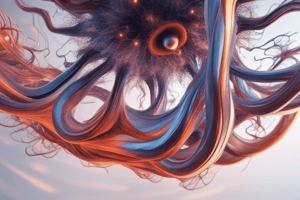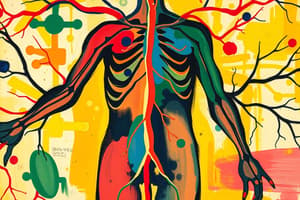Podcast
Questions and Answers
What is the primary neurotransmitter used in sympathetic pathways?
What is the primary neurotransmitter used in sympathetic pathways?
- Dopamine
- Norepinephrine (correct)
- Epinephrine
- Acetylcholine
Which nerve carries approximately 75% of all parasympathetic fibers?
Which nerve carries approximately 75% of all parasympathetic fibers?
- Phrenic Nerve
- Sciatic Nerve
- Median Nerve
- Vagus Nerve (correct)
Why do we see antagonistic control primarily at the SA node and not in other areas such as the ventricles or arterioles?
Why do we see antagonistic control primarily at the SA node and not in other areas such as the ventricles or arterioles?
- Only the SA node regulates blood flow.
- The SA node requires independent control.
- Ventricles are innervated exclusively by sympathetic pathways.
- Antagonistic control is not needed in those areas. (correct)
Which of the following statements about parasympathetic pathways is correct?
Which of the following statements about parasympathetic pathways is correct?
What do sympathetic ganglia resemble in terms of structure?
What do sympathetic ganglia resemble in terms of structure?
What is the role of the vagus nerve in relation to internal organs?
What is the role of the vagus nerve in relation to internal organs?
In comparison to parasympathetic pathways, which neurotransmitter is NOT used by sympathetic pathways?
In comparison to parasympathetic pathways, which neurotransmitter is NOT used by sympathetic pathways?
Which of the following best describes the overall function of antagonistic control in the autonomic system?
Which of the following best describes the overall function of antagonistic control in the autonomic system?
What are the two components required for the synthesis of acetylcholine?
What are the two components required for the synthesis of acetylcholine?
Which enzyme is responsible for breaking down acetylcholine in the synaptic cleft?
Which enzyme is responsible for breaking down acetylcholine in the synaptic cleft?
How is choline transported back into the axon terminal?
How is choline transported back into the axon terminal?
What role does recycled choline play after its transport back into the axon terminal?
What role does recycled choline play after its transport back into the axon terminal?
Where does the synthesis of acetylcholine primarily occur?
Where does the synthesis of acetylcholine primarily occur?
Which receptor is associated with the parasympathetic pathway?
Which receptor is associated with the parasympathetic pathway?
What neurotransmitter is primarily used in sympathetic pathways?
What neurotransmitter is primarily used in sympathetic pathways?
Which pathway involves the adrenal medulla?
Which pathway involves the adrenal medulla?
What are the target tissues of the parasympathetic pathway?
What are the target tissues of the parasympathetic pathway?
Which of the following is a characteristic of the somatic motor pathway?
Which of the following is a characteristic of the somatic motor pathway?
What is the major difference in the number of neurons between the somatic motor and autonomic pathways?
What is the major difference in the number of neurons between the somatic motor and autonomic pathways?
Which receptor subtype is responsible for responding to epinephrine?
Which receptor subtype is responsible for responding to epinephrine?
What neurotransmitter is used by the adrenal sympathetic pathway?
What neurotransmitter is used by the adrenal sympathetic pathway?
Which receptor is primarily activated by acetylcholine in the sympathetic pathway?
Which receptor is primarily activated by acetylcholine in the sympathetic pathway?
What triggers the exocytosis of synaptic vesicles at the varicosity?
What triggers the exocytosis of synaptic vesicles at the varicosity?
Which type of receptors do all adrenergic receptors belong to?
Which type of receptors do all adrenergic receptors belong to?
What happens to norepinephrine (NE) after it binds to the receptor on the target cell?
What happens to norepinephrine (NE) after it binds to the receptor on the target cell?
What is the effect of increased neurotransmitter concentration in the synapse?
What is the effect of increased neurotransmitter concentration in the synapse?
Which ion entry is responsible for the depolarization that triggers exocytosis?
Which ion entry is responsible for the depolarization that triggers exocytosis?
What is the primary role of norepinephrine (NE) at a sympathetic neuroeffector junction?
What is the primary role of norepinephrine (NE) at a sympathetic neuroeffector junction?
How do adrenergic receptors influence the speed of the response?
How do adrenergic receptors influence the speed of the response?
What initiates the release of norepinephrine (NE) at a sympathetic neuroeffector junction?
What initiates the release of norepinephrine (NE) at a sympathetic neuroeffector junction?
What begins the action potential at the varicosity?
What begins the action potential at the varicosity?
Which process describes the removal of norepinephrine from the synapse?
Which process describes the removal of norepinephrine from the synapse?
Which process is responsible for removing norepinephrine (NE) from the synaptic cleft?
Which process is responsible for removing norepinephrine (NE) from the synaptic cleft?
What is the outcome of the activation of adrenergic receptors?
What is the outcome of the activation of adrenergic receptors?
What role do voltage-gated Ca2+ channels play in the sympathetic neuroeffector junction?
What role do voltage-gated Ca2+ channels play in the sympathetic neuroeffector junction?
Which statement about norepinephrine (NE) is incorrect in the context of its release and removal?
Which statement about norepinephrine (NE) is incorrect in the context of its release and removal?
Where does the action potential initiate the process of norepinephrine (NE) release?
Where does the action potential initiate the process of norepinephrine (NE) release?
How is norepinephrine (NE) synthesized before it is released?
How is norepinephrine (NE) synthesized before it is released?
What effect does norepinephrine (NE) binding to adrenergic receptors generally have?
What effect does norepinephrine (NE) binding to adrenergic receptors generally have?
What happens to norepinephrine (NE) after it is released into the synaptic cleft?
What happens to norepinephrine (NE) after it is released into the synaptic cleft?
Which of the following is a characteristic of norepinephrine (NE) metabolism?
Which of the following is a characteristic of norepinephrine (NE) metabolism?
Study Notes
Autonomic and Somatic Motor Control
- Antagonistic control is primarily observed at the Sinoatrial (SA) node, not in ventricular tissues, veins, or arterioles.
- Sympathetic ganglia are organized in two chains alongside the vertebral column.
Vagus Nerve
- Comprises approximately 75% of all parasympathetic fibers.
- Carries sensory information from internal organs to the brain and transmits signals from the brain to organs.
Autonomic Pathways
-
Parasympathetic Pathway:
- Use acetylcholine (ACh) neurotransmitter.
- Involves muscarinic receptors at target tissues, affecting smooth muscle, cardiac muscle, certain glands, and adipose tissue.
-
Sympathetic Pathway:
- Predominantly uses norepinephrine (NE) and also ACh.
- Target cells possess alpha (α) and beta (β) adrenergic receptors.
Neurotransmitter Mechanism
- Norepinephrine release occurs at sympathetic neuroeffector junctions upon action potential arrival.
- Depolarization leads to the opening of voltage-gated Ca²⁺ channels, facilitating exocytosis of vesicles containing NE.
- NE binds to adrenergic receptors on target cells, initiating a signal that is prolonged as NE diffuses away.
Neurotransmitter Release and Removal
- NE concentration modulation leads to varied responses; higher levels produce stronger or longer-lasting effects.
- NE can be reabsorbed into synaptic vesicles or metabolized by monoamine oxidase (MAO) after exerting its effect.
Acetylcholine Mechanism
- ACh is synthesized from choline and acetyl CoA in the axon terminals.
- Rapid breakdown of ACh occurs in the synaptic cleft due to acetylcholinesterase (AChE).
- Choline is recycled back into the axon terminal for the re-synthesis of ACh.
Comparison of Pathways
- Somatic motor pathways consist of a single neuron connecting CNS to the target muscle.
- Autonomic pathways typically involve two neurons, with the first neuron synapsing in a ganglion.
Receptors and Effects
- Somatic motor pathways use nicotinic receptors at the neuromuscular junction.
- Sympathetic pathways can activate both α and β adrenergic receptors, leading to diverse physiological responses.
- Parasympathetic pathways typically activate muscarinic receptors.
Neuroeffector Junction Dynamics
- Response time for adrenergic receptor binding is slower compared to ion channel receptors due to reliance on G-protein signaling cascades.
Studying That Suits You
Use AI to generate personalized quizzes and flashcards to suit your learning preferences.
Related Documents
Description
This quiz covers the key concepts of autonomic and somatic motor control as presented in Chapter 11 Part B of the physiology textbook. Evaluate your understanding of physiological mechanisms, particularly focusing on antagonistic control. Prepare to test your knowledge on the details discussed in the chapter.




